Overview and State of the Art in the Management of Lung Cancer
Lung cancer is a major health problem worldwide. Non–small-celllung cancer (NSCLC) accounts for 80% to 85% of all lung cancers,while small-cell lung cancer (SCLC) accounts for 15% to 20% of cases.For early-stage and locally advanced NSCLC (stages I through III), amultimodality treatment approach is appropriate because it improvessurvival. Combination chemotherapy is currently the standard treatmentfor good performance patients with metastatic disease. Elderlypatients (≥ 70 years) with metastatic NSCLC also benefit from treatment.In SCLC, concurrent radiation therapy and chemotherapy is thestandard for limited disease, while chemotherapy is the treatment forextensive disease. Novel innovative therapies, which could includemolecular targeting agents, are needed to treat both NSCLC and SCLC.
ABSTRACT: Lung cancer is a major health problem worldwide. Nonâsmall-celllung cancer (NSCLC) accounts for 80% to 85% of all lung cancers,while small-cell lung cancer (SCLC) accounts for 15% to 20% of cases.For early-stage and locally advanced NSCLC (stages I through III), amultimodality treatment approach is appropriate because it improvessurvival. Combination chemotherapy is currently the standard treatmentfor good performance patients with metastatic disease. Elderlypatients (⥠70 years) with metastatic NSCLC also benefit from treatment.In SCLC, concurrent radiation therapy and chemotherapy is thestandard for limited disease, while chemotherapy is the treatment forextensive disease. Novel innovative therapies, which could includemolecular targeting agents, are needed to treat both NSCLC and SCLC.
Worldwide, more than 1.2million people are diagnosedeach year with lungcancer, and approximately 1.1 millionwill die from the disease. In theUnited States, it is estimated that in2004, 173,770 individuals will be diagnosedand 160,440 will die fromlung cancer.[1] Non-small-cell lungcancer (NSCLC) accounts for approximately80% to 85% of all cases ofdiagnosed lung cancer, while smallcelllung cancer (SCLC) accounts forthe remainder of cases. This paperwill highlight recent advances in thetreatment of both NSCLC and SCLC.Stages of Lung CancerStaging of NSCLC is based on theTNM classification. For SCLC, stagingit is divided into limited disease(LD) or extensive disease (ED). Table1 provides the staging of lungcancer as well as 1-and 5-year survivalrates for each stage of disease.[2]Non-Small-Cell Lung CancerAdjuvant Therapy
Radiation therapy (RT) and chemotherapyhave been utilized as ad-juvant therapy following surgical resectionof NSCLC (see Table 2 for anoverview). A meta-analysis of postoperativeRT from nine phase III trialscompared postoperative RT to nopostoperative therapy in stage I to IIIdisease. The results demonstrated anadverse effect of RT on survival,[3]which was statistically significant;55% of surgery-alone patients survived2 years compared with 48% ofthose patients receiving postoperativeradiation therapy. The dose of RT variedfrom 30 to 65 Gy.In 1995, a meta-analysis evaluatingchemotherapy as postoperativeadjuvant chemotherapy reported thatalkylating agents were detrimental topatients while cisplatin-based chemo-therapy produced a 13% decrease inthe risk of death (hazard ratio, 0.87;P = .08).[4]In 2000, the Eastern CooperativeOncology Group (ECOG) comparedradiation therapy (50.4 Gy) to RT plusetoposide and cisplatin given postoperativelyto patients with stage II andIIIA disease.[5] In both stages, therewas no difference in survival or localrecurrences whether the patient receivedpostoperative RT or postoperativeRT/chemotherapy. The study didnot include a surgery-alone arm.In the randomized International AdjuvantLung Cancer Trial (IALT),[6]1,867 patients with stage I to III NSCLCreceived either adjuvant cisplatin-basedCT or no therapy postoperatively. Therewas an absolute 4% 5-year survival(P < .03) advantage for those receivingchemotherapy (44.5% vs 40.4%).Disease-free survival (39% vs 34%)was also significantly different at 5years (P < .003). Age, gender, performancestatus, type of surgery, or useof RT had no effect on survival.
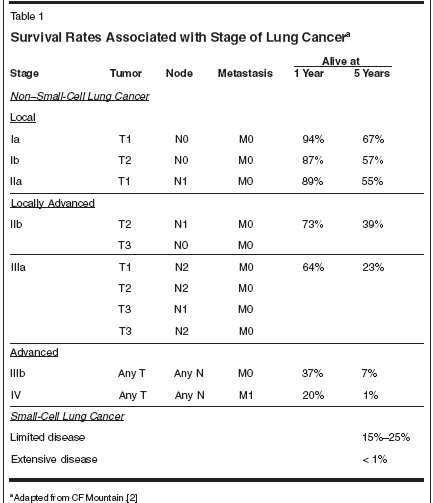
Neoadjuvant Therapy
Neoadjuvant CT in resectableNSCLC appears to improve survivalrates (Table 3).[7-10] In three smallstudies involving 60 stage IIIA or lesspatients, there was a statistical survivaladvantage in patients receiving preoperativechemotherapy.[7-9] Pass etal reported a 3-year survival advantageof 40% vs 12% and median survivalof 28.7 vs 15.6 months(P = .095). Roth et al[8] demonstrateda 3-year survival of 56% vs 15%and median survival of 64 months vs11 months (P = .008). Rosell et al[9]reported a 3-year survival of 23% vs0% and median survival of 26 vs 8months (P < .001).In a large neoadjuvant chemotherapystudy of 355 stage IB and IIIApatients, Depierre et al reported a statisticallysignificant survival advantagefor patients with stage I and IIdisease receiving neoadjuvant chemotherapy(2-year survival, 52% vs 41%;P = .04).[10] For stage III disease,there was no statistically significantdifference.Chemotherapy/RT forUnresectable Stage III Disease
Neoadjuvant chemotherapy followedby RT for stage III NSCLC hasbeen shown to be superior to RT givenalone.[11,12] Dillman et al reportedthat two cycles of cisplatin plusvinblastine followed by RT (60 Gy)vs RT (60 Gy) alone produced a mediansurvival of 13.8 vs 9.7 monthswith a 7-year survival of 13% vs 6%.A phase III Intergroup study utilizingthe regimens in the Dillman et al studyplus a third arm involving hyperfractionatedRT demonstrated a statisticallysignificant advantage ofchemotherapy/RT over RT alone(1-year survival, 59% vs 46%; 5-yearsurvival, 8% vs 5%).[13]It appears that concurrent chemoradiationtherapy is more effectivethan sequential therapy in the treatmentof unresectable stage III NSCLC(Table 4).[14,15]Furuse et al reported that concurrentmitomycin (Mutamycin), vindesine,and cisplatin (MVP) 2 + RT28 Gy followed by 2 weeks rest andthen RT 28 Gy is statistically significantlybetter than sequential MVP 2followed by RT (56 Gy) in unresectablestage III NSCLC.[14] The mediansurvival was 16.5 vs 13.3 months;5-year survival was 16% vs 8.9%(P = .01).The Radiation Therapy OncologyGroup (RTOG) conducted a phase IIIstudy comparing concurrent with sequentialchemotherapy/RT as well asconcurrent chemotherapy with hyperfractionatedRT.[15] For the concurrentchemotherapy/RT vs sequentialtherapy, median survival was 17.0 vs14.6 months, and 4-year survival was21% vs 12% (P = .046). However,grade 3/4 esophagitis was 25% withconcurrent therapy but only 4% withsequential therapy.Stage IIIB/Stage IV Disease
Combination chemotherapy is currentlythe standard treatment for goodperformance patients with stage IIIB(pleural effusion)/stage IV NSCLC.A meta-analysis from 52 randomizedclinical trials demonstrated a survivaladvantage for advanced NSCLC patientsreceiving chemotherapy.[4]The increase in median survivalwas 2 months, with a 10% increase in1-year survival. A number of twoagentcombinations are active againstadvanced NSCLC.[16-20] Activeagents such as paclitaxel, docetaxel(Taxotere), gemcitabine (Gemzar), vinorelbine(Navelbine), and irinotecan(Camptosar) have been combined withcisplatin or carboplatin to treat patientswith advanced NSCLC (Table 5).In general, such two-agent combinationsproduce response rates of 20%to 50%, median survivals of 8 to 10months, 1- and 2-year survival ratesof 30% to 35% and 10% to 15%,respectively.The use of chemotherapy is effectivein treating the elderly withNSCLC (Table 6).[21,22] In the ElderlyLung Cancer Vinorelbine ItalianStudy (ELVIS) trial,[21] untreatedstage IIIB/IV patients ≥ 70 years ofage were randomized to receive vinorelbineor no therapy. Median survivaland 1-year survival in patientsreceiving chemotherapy comparedwith observation was 6.5 months and32% vs 4.9 months and 14%, respectively(P = .03).[21] Other studies haveshown that chemotherapy can be givento the elderly.[22]In the United States, docetaxel isapproved for use as second-line therapyfor patients with advancedNSCLC.[23] Hanna et al recently reportedon pemetrexed (Alimta) comparedwith docetaxel as second-linetherapy.[24] The response rate andsurvival rates were similar; however,pemetrexed was less toxic (Table 7).To improve the therapy of patientswith NSCLC, new agents with uniquemechanisms of action are being evaluated.Targeted therapies are suchagents.[25,26] Inhibitors of epidermalgrowth factor receptors (EGFR) suchas gefitinib (Iressa) have been studied(Table 8).[26] While gefitinib has beenshown to be effective in advancedNSCLC patients who previously failedone or more regimens,[27,28] whencombined with chemotherapy, therewas no advantage to those patientsreceiving chemotherapy alone.[29] Assecond- or third-line therapy, the responserate was 9% to 20%, with survivalrates of 7 to 8 months. The majortoxicity has been acneiform rash anddiarrhea. Gefitinib was first approvedfor use in Japan. Less than 1% ofpatients receiving the drug developedpulmonary interstitial disease. Othermolecular targeted therapies includingbevacizumab and cetuximab arebeing studied.[30,31]
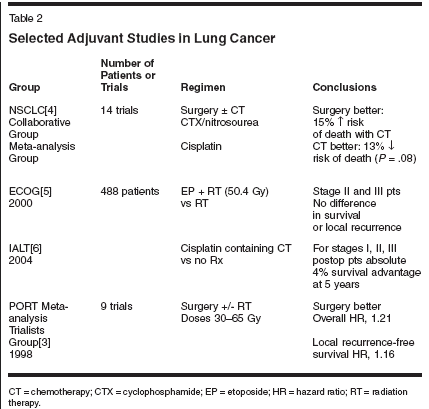
Small-Cell Lung CancerSmall-cell lung cancer accounts for15% to 20% of lung cancer diagnosedin the United States. Small-cell lungcancer is divided into limited disease(LD) or extensive disease (ED). Thecornerstone of treatment of SCLC ischemotherapy. LD SCLC is treatedwith chemotherapy and radiation therapy.[32] The 5-year survival rates withappropriate therapy are 15% to 25%.The use of hyperfractionated (twicedaily)radiation therapy with chemotherapyappears superior to that usedwith daily radiation therapy.[33] However,Schild et al reported results of aphase III study that showed splitcourse,twice-daily RT was not superiorto once-a-day RT in LD SCLC(Table 9).[34]In ED SCLC, median survival is 8to 10 months with chemotherapy. Etoposide/carboplatin (Paraplatin) is aseffective as etoposide/cisplatin intreating patients with ED SCLC.[35]More recently, irinotecan/cisplatinwas shown to be superior to etoposide/cisplatin in patients with EDSCLC (Table 10).[36]For relapsed SCLC, chemotherapyis more effective in patients whohave sensitive rather than refractorydisease (Table 10).[37]ConclusionsSince 1990, progress, albeit modest,has been made in the treatment oflung cancer, especially NSCLC. Combined-modality therapy is now usedin resectable (stage I to III) as well aslocally advanced unresectable (stageIII) disease. Adjuvant chemotherapyproduced an absolute 5% survival advantagefor patients with surgically resectablestage I to III disease.Chemotherapy plus RT is standard therapyfor locally advanced unresectableNSCLC. Concurrent chemotherapy/RTappears more effective than sequentialchemotherapy and RT in treatingsuch disease. Newer agents used incombination chemotherapy have improvedsurvival and quality of life inNSCLC patients with metastatic disease.With the availability of moleculartargeted therapies, treatment ofsuch patients appears promising.
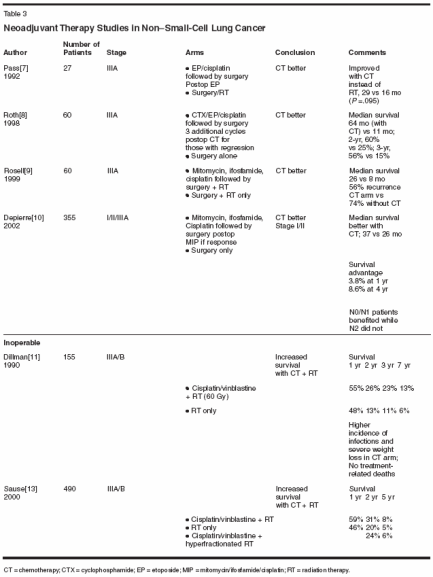
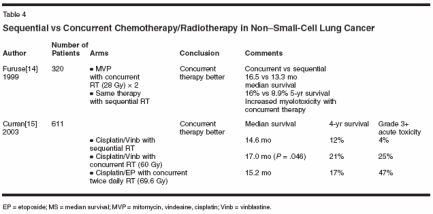
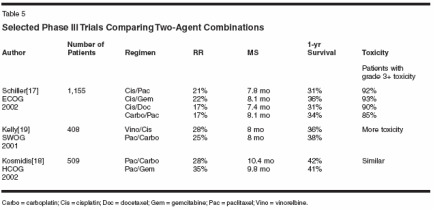
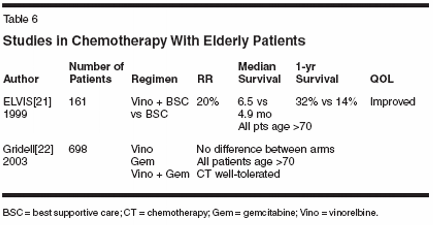
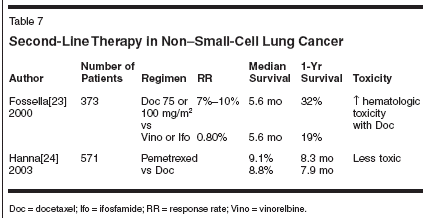
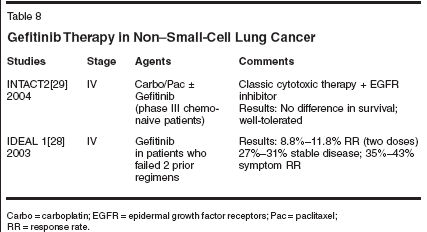
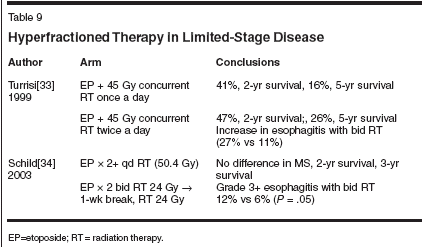
Some progress has been made inthe treatment of SCLC. Chemotherapyremains the cornerstone of therapy.In LD SCLC, concurrentchemotherapy/RT is the treatment ofchoice. For ED SCLC patients, irinotecanplus cisplatin appears more effectivethan the standard therapy ofetoposide plus cisplatin.
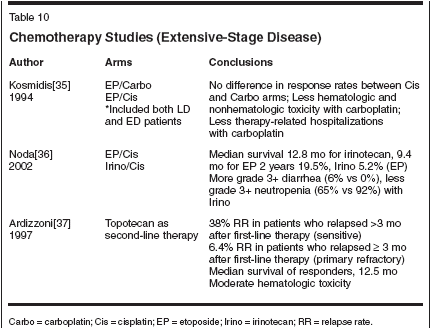
Disclosures:
Dr. Ettinger has receivedgrant/research support from Aventis andEli Lilly. He has received honoraria from andacted as a consultant for AstraZeneca, Aventis,Bristol-Myers Squibb, Eli Lilly, GSK, Merck,MGI Pharma, and Pfizer. He has acted as a consultantfor Cell Therapeutics.
References:
1.
Jemal A, Tiwari RC, Murray T, et al: Cancerstatistics, 2004. CA Cancer J Clin 54:8-29,2003.
2.
Mountain CF: Revisions in the InternationalSystem for Staging Lung Cancer. Chest111:1710-1717, 1997.
3.
PORT Meta-analysis Trialists Group:Postoperative radiotherapy in non-small-celllung cancer: Systematic review and meta-analysisof individual patient data from nine randomizedcontrolled trials. Lancet 352:257-263,1998.
4.
Non-Small Cell Lung Cancer CollaborativeGroup: Chemotherapy in non-small celllung cancer: A meta-analysis using updateddata on individual patients from 52 randomisedclinical trials. Br Med J 311:899-909, 1995.
5.
Keller SM, Adak S, Wagner H, et al: Arandomized trial of postoperative adjuvanttherapy in patients with completely resectedstage II or IIIA non-small-cell lung cancer.Eastern Cooperative Oncology Group. N EnglJ Med 343:1217-1222, 2000.
6.
The International Adjuvant Lung CancerTrial Collaborative Group: Cisplatin-basedadjuvant chemotherapy in patients with completelyresected nonâsmall-cell lung cancer. NEngl J Med 350:351-360, 2004.
7.
Pass HI, Pogrebniak HW, Steinberg SM,et al: Randomized trial of neoadjuvant therapyfor lung cancer: Interim analysis. Ann ThoracSurg 53:992-998, 1992.
8.
Roth JA, Atkinson EN, Fossella F, et al:Long-term follow-up of patients enrolled in arandomized trial comparing perioperative chemotherapyand surgery with surgery alone inresectable stage IIIA non-small-cell lung cancer.Lung Cancer 21:1-16, 1998.
9.
Rosell R, Gomez-Codina J, Camps C, etal: Preresectional chemotherapy in stage IIIAnon-small-cell lung cancer: A 7-year assessmentof a randomized controlled trial. LungCancer 26:7-14, 1999.
10.
Depierre A, Milleron B, Moro-Sibilot D,et al: Preoperative chemotherapy followed bysurgery compared with primary surgery in resectablestage I (except T1N0), II, and IIIa nonsmall-cell lung cancer. J Clin Oncol 20:247-253, 2002.
11.
Dillman RO, Seagren SL, Propert KJ, etal: A randomized trial of induction chemotherapyplus high-dose radiation versus radiationalone in stage III non-small-cell lung cancer.N Engl J Med 323:940-945, 1990.
12.
Dillman RO, Herndon J, Seagren SL, etal: Improved survival in stage III non-smallcelllung cancer: Seven-year follow-up of cancerand leukemia group B (CALGB) 8433 trial.J Natl Cancer Inst 88:1210-1215, 1996.
13.
Sause W, Kolesar P Taylor S, et al: Finalresults of phase III trial in regionally advancedunresectable non-small cell lung cancer-RadiationTherapy Oncology Group (RTOG) 88-08 and Eastern Cooperative Oncology Group(ECOG) 4588. Chest 117:358-364, 2000.
14.
Furuse K, Fukuoka M, Kawahara M, etal: Phase III study of concurrent versus sequentialthoracic radiotherapy in combination withmitomycin, vindesine, and cisplatin inunresectable stage III non-small-cell lung cancer.J Clin Oncol 17:2692-2699, 1999.
15.
Curran W, Scott CB, Langer CJ, et al:Long-term benefit is observed in a phase IIIcomparison of sequential vs. concurrentchemoradiation for patients with unresectablestage III NSCLC: RTOG 9410 (abstract 2499).Proc Am Soc Clin Oncol 22:621, 2003.
16.
Ettinger DS: Is there a preferred combinationchemotherapy regimen for metastaticnon-small cell lung cancer? Oncologist 7:226-233, 2002.
17.
Schiller JH, Harrington D, Belani CP, etal: Comparison of four chemotherapy regimensfor advanced non-small-cell lung cancer. NEngl J Med 346:92-98, 2002.
18.
Kosmidis P, Mylonakis N, Nicolaides C,et al: Paclitaxel plus carboplatin versusgemcitabine plus paclitaxel in advanced nonsmall-cell lung cancer: A phase III randomizedtrial. J Clin Oncol 20:3578-3585, 2002.
19.
Kelly K, Crowley J Bunn PA, Jr, et al:Randomized phase III trial of paclitaxel pluscarboplatin versus vinorelbine plus cisplatin inthe treatment of patients with advanced nonsmall-cell lung cancer: A Southwest OncologyGroup trial. J Clin Oncol 19:3210-3218, 2001.
20.
Lilenbaum R, Hendon J, List M, et al:Single-agent (SA) versus combination chemotherapy(CC) in advanced non-small cell lungcancer (NSCLC): A CALGB randomized trialof efficacy, quality of life and cost effectiveness(abstract 2). Proc Am Soc Clin Oncol21:1a, 2002.
21.
The Elderly Lung Cancer VinorelbineItalian Study Group: Effects of vinorelbine onquality of life and survival of elderly patientswith advanced non-small-cell lung cancer. JNatl Cancer Inst 91:66-72, 1999.
22.
Gridelli C, Perrone F, Gallo C, et al:Chemotherapy for elderly patients with advancednon-small-cell lung cancer: TheMulticenter Italian Lung Cancer in the ElderlyStudy (MILES) phase III randomized trial. JNatl Cancer Inst 95:362-372, 2003.
23.
Fossella FV, DeVore R, Kerr RN, et al:Randomized phase III trial of docetaxel versusvinorelbine or ifosfamide in patients with advancednon-small cell lung cancer previouslytreated with platinum-containing chemotherapyregimens. The TAX 320 Non-Small Cell LungCancer Study Group. J Clin Oncol 18:2354-2362 2000.
24.
Hanna NH, Shepherd FA, Fosella FV, etal: Randomized phase III study of pemetrexedvs docetaxel in patients with non-small celllung cancer previously treated with chemotherapy.J Clin Oncol 22:1589-1597, 2004.
25.
Salgia R, Skarin AT: Molecular abnormalitiesin lung cancer. J Clin Oncol 16:1207-1217, 1998.
26.
Dy GK, Adjei AA: Novel targets for lungcancer therapy: Part I and part II. J Clin Oncol20:2881-2894, 3016-3028, 2002.
27.
Kris MG, Natale RB, Herbst RS, et al:Efficacy of gefitinib, an inhibitor of the epidermalgrowth factor receptor tyrosine kinasein symptomatic patients with nonâsmall celllung cancer: A randomized trial. JAMA290:2149-2158, 2003.
28.
Fukuoka M, Yano S, Giaccone G, et al:Multi-institutional randomized phase II trial ofgefitinib for previously treated patients withadvanced non-small-cell lung cancer. J ClinOncol 21:2237-2246, 2003.
29.
Herbst RS, Giaccone G, Schiller JH, etal: Gefitinib in combination with paclitaxel andcarboplatin in advanced non-small-cell lungcancer: A phase III trial-INTACT2. J ClinOncol 22:785-794, 2004.
30.
DeVore RF, Fehrenbacher L, Herbst RS,et al: A randomized phase II trial comparingrhumab VEGF (recombinant humanized monoclonalantibody to vascular endothelial growthfactor) plus carboplatin/paclitaxel (CP) to CPalone in patients with stage IIB/IV NSCLC (abstract1896). Proc Am Soc Clin Oncol 19:485a,2000.
31.
Gatzemeier U, Rosell R, Ramlau R, etal: Cetuximab (C225) in combination withcisplatin/vinorelbine vs cisplatin/vinorelbinealone in the first-line treatment of patients (pts)with epidermal growth factor receptor (EGFR)positive advanced non-small cell lung cancer(abstract 2582). Proc Am Soc Clin Oncol22:642, 2003.
32.
Takada M, Fukuoka M, Kawahara M, etal: Phase III study of concurrent versus sequentialthoracic radiotherapy in combination withcisplatin and etoposide for limited-stage smallcelllung cancer: Results of the Japan ClinicalOncology Group Study 9104. J Clin Oncol20:3054-3060, 2002.
33.
Turrisi AT, III, Kim K, Blum R, et al:Twice daily compared with once-daily thoracicradiotherapy in limited small-cell lung cancertreated concurrently with cisplatin andetoposide. N Engl J Med 340:265-271, 1999.
34.
Schild S, Brindle JS, Geyer SM, et al:Long-term results of a phase III trial comparingonce a day radiotherapy (QD RT) or twicea day radiotherapy (BIDRT) in limited stagesmall cell lung cancer (LSCLC) (abstract 2536).Proc Am Soc Clin Oncol 22:631, 2003.
35.
Kosmidis PA, Smantas E, Fountzilas G,et al: Cisplatin/etoposide versus carboplatin/etoposide chemotherapy and irradiation insmall cell lung cancer: A randomized phase IIIstudy. Hellenic Cooperative Oncology Groupfor Lung Cancer Trials. Semin Oncol 21(2 suppl6):23-30, 1994.
36.
Noda K, Nishiwaki Y, Kawahara M, etal: Irinotecan plus cisplatin compared withetoposide plus cisplatin for extensive small-celllung cancer. N Engl J Med 346:85-91, 2002.
37.
Ardizzoni A, Hansen H, DombernowskyP, et al: Topotecan, a new active drug in thesecond-line treatment of small-cell lung cancer:A phase II study in patients with refractoryand sensitive disease. The European Organizationfor Research and Treatment of CancerEarly Clinical Studies Group and New DrugDevelopment Office, and the Lung CancerCooperative Group. J Clin Oncol 15:2090-2096, 1997.